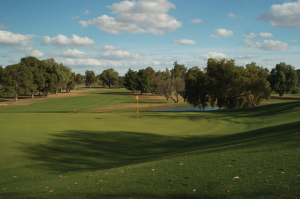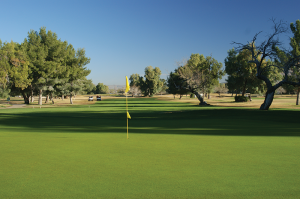The City of Tucson’s municipal golf courses have a long and rich history in the game of golf, dating all the way back to the 1920s and 30s. Through the years, golf greats such as Byron Nelson, Arnold Palmer and Johnny Miller have all teed it up on Tucson’s exceptional municipal courses. Years later, thanks to forward-thinking by the City of Tucson and OB Sports Golf Management, the city’s golf courses will continue to deliver a quality golf experience for residents and winter visitors alike for years to come.
OB Sports was hired by the city this past February as the new golf management company that will oversee maintenance, operations and marketing at Tucson’s five municipal courses. The 42-year-old, Scottsdale-based company is committed to revitalizing these five clubs in a way that honors the proud traditions established by generations of Tucsonians. In just a short time since coming on board, course conditions have already improved and a handful of frequent-player programs have been put in place. Most recently, all five courses received new fleets of golf cars – a fact frequent players will love to hear.
The centrally located Dell Urich Golf Course opened in 1996 after complete re-design on the site of the former Randolph South Golf Course. The dramatic makeover opened up sight lines to reveal nearby mountain views as well as dramatic elevation changes. Measuring more than 6,600 yards from the back tees and 5,300 from the fronts, the course hosted an LPGA Tour stop for several years. Best of all, if you’re up for 36 holes, Randolph Golf Complex with its Randolph North Golf Course is just next door.

Randolph opened in 1925, and was the site of the PGA Seiko Tucson Match Play Championship, the PGA Joe Garagiola Tucson Open and the PING/Welch’s LPGA Championship. It stretches out to be the longest of the Tucson City golf courses at 6,900 yards from the championship tees and just short of 6,000 from the front tees. Although it’s a park-land style layout where wayward golf balls are easily found, palms, pines and other mature trees frame the challenges as well as Tucson’s colorful skyline — an iconic view that has been drawing golfers to this area of the Sonoran Desert for generations.

Holding true to a Tucson tradition of hosting competitive golf at the highest levels, El Rio Golf Course’s pedigree as a championship track dates back the 1930s as the original site of the PGA Tour’s Tucson Open. Truly traditional by design, it was a private club for much of its existence until the City of Tucson acquired it for public use. Since 1968, El Rio has been challenging golfers to a game of risk and reward punctuated by fairways that are a bit tighter and greens that are a bit smaller than those of its sister courses. All of this calls for more precision. Good news: it plays shorter at 6,400 yards from the back tees, nearly 5,400 from the front tees, and El Rio also features junior tees measuring less than 4,700 yards.
Silverbell Golf Course sits high upon the west bank of the Santa Cruz River. The par-70 course features a variety of holes ranging from wide-open, come-and-get-it challenges to others that require precision over length. Although golfers face the second-hardest hole early in the round at No. 2, holes 17 and 18 tend to be the high-water mark where it’s either sink or swim. No. 17 requires an approach shot squeezed between water on the left and a bunker to the right. And the 18th is a traditional three-shot par 5 at 551 yards. Their handicaps are 3rd and 1st respectively. Like its cousins, large trees and even a few water hazards sprinkled throughout provide this 6,824-yard layout with its aesthetic as well as strategic appeal. It’s a great course for a variety of abilities from junior to expert, and walking is a very enjoyable option.
As the true desert course among its peers, Fred Enke offers a rugged Sonoran Desert-style round of golf that blends into the surrounding native landscape frequented by road runners, coyotes and even the occasional Bobcat. Upon first glance, it may be a bit unclear where to place a few of the tee shots, but just over this arroyo or around that hill, a well-struck shot will find the short grass. Indeed, Fred Enke is one of those courses that reveals its secrets slowly as you experience it. This makes for an interesting round of golf whether it’s the first or the tenth. The golf course embraces a semi-arid, limited-turf design with grass mostly on the tee boxes, landing areas and greens. Surrounding areas are left undisturbed for native plants and animals to thrive.

All five courses stack up well against other clubs in the area for strategy, playability, and fun. When it comes to deciding where to play with reasonable greens fees, it makes Tucson’s municipal golf courses a popular choice.


